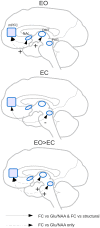Glutamate concentration in the medial prefrontal cortex predicts resting-state cortical-subcortical functional connectivity in humans
- PMID: 23573246
- PMCID: PMC3616113
- DOI: 10.1371/journal.pone.0060312
Glutamate concentration in the medial prefrontal cortex predicts resting-state cortical-subcortical functional connectivity in humans
Erratum in
- PLoS One. 2013;8(65). doi:10.1371/annotation/8a1feb12-d70a-4fb2-8dcb-a9cad56c3afd. Marjańska, Malgoranza [corrected to Marjańska, Malgorzata]
Abstract
Communication between cortical and subcortical regions is integral to a wide range of psychological processes and has been implicated in a number of psychiatric conditions. Studies in animals have provided insight into the biochemical and connectivity processes underlying such communication. However, to date no experiments that link these factors in humans in vivo have been carried out. To investigate the role of glutamate in individual differences in communication between the cortex--specifically the medial prefrontal cortex (mPFC)--and subcortical regions in humans, a combination of resting-state fMRI, DTI and MRS was performed. The subcortical target regions were the nucleus accumbens (NAc), dorsomedial thalamus (DMT), and periaqueductal grey (PAG). It was found that functional connectivity between the mPFC and each of the NAc and DMT was positively correlated with mPFC glutamate concentrations, whilst functional connectivity between the mPFC and PAG was negatively correlated with glutamate concentration. The correlations involving mPFC glutamate and FC between the mPFC and each of the DMT and PAG were mirrored by correlations with structural connectivity, providing evidence that the glutamatergic relationship may, in part, be due to direct connectivity. These results are in agreement with existing results from animal studies and may have relevance for MDD and schizophrenia.
Conflict of interest statement
Figures



Similar articles
-
Altered neuronal spontaneous activity correlates with glutamate concentration in medial prefrontal cortex of major depressed females: An fMRI-MRS study.J Affect Disord. 2016 Sep 1;201:153-61. doi: 10.1016/j.jad.2016.05.014. Epub 2016 May 12. J Affect Disord. 2016. PMID: 27235818
-
The right thalamic glutamate level correlates with functional connectivity with right dorsal anterior cingulate cortex/middle occipital gyrus in unmedicated obsessive-compulsive disorder: A combined fMRI and 1H-MRS study.Aust N Z J Psychiatry. 2019 Mar;53(3):207-218. doi: 10.1177/0004867418806370. Epub 2018 Oct 24. Aust N Z J Psychiatry. 2019. PMID: 30354192
-
The increase in medial prefrontal glutamate/glutamine concentration during memory encoding is associated with better memory performance and stronger functional connectivity in the human medial prefrontal-thalamus-hippocampus network.Hum Brain Mapp. 2018 Jun;39(6):2381-2390. doi: 10.1002/hbm.24008. Epub 2018 Feb 27. Hum Brain Mapp. 2018. PMID: 29488277 Free PMC article.
-
Functional relationship among medial prefrontal cortex, nucleus accumbens, and ventral tegmental area in locomotion and reward.Crit Rev Neurobiol. 2000;14(2):131-42. Crit Rev Neurobiol. 2000. PMID: 11513242 Review.
-
The structural and functional connectivity of the posterior cingulate cortex: comparison between deterministic and probabilistic tractography for the investigation of structure-function relationships.Neuroimage. 2014 Nov 15;102 Pt 1:118-27. doi: 10.1016/j.neuroimage.2013.12.022. Epub 2013 Dec 21. Neuroimage. 2014. PMID: 24365673 Review.
Cited by
-
The cross-sectional interplay between neurochemical profile and brain connectivity.Hum Brain Mapp. 2021 Jun 15;42(9):2722-2733. doi: 10.1002/hbm.25396. Epub 2021 Apr 9. Hum Brain Mapp. 2021. PMID: 33835605 Free PMC article.
-
Reduced Glutamate in the Medial Prefrontal Cortex Is Associated With Emotional and Cognitive Dysregulation in People With Chronic Pain.Front Neurol. 2019 Dec 3;10:1110. doi: 10.3389/fneur.2019.01110. eCollection 2019. Front Neurol. 2019. PMID: 31849800 Free PMC article.
-
Effect of Risperidone Monotherapy on Dynamic Functional Connectivity of Insular Subdivisions in Treatment-Naive, First-Episode Schizophrenia.Schizophr Bull. 2020 Apr 10;46(3):650-660. doi: 10.1093/schbul/sbz087. Schizophr Bull. 2020. PMID: 31504959 Free PMC article.
-
Why are cortical GABA neurons relevant to internal focus in depression? A cross-level model linking cellular, biochemical and neural network findings.Mol Psychiatry. 2014 Sep;19(9):966-977. doi: 10.1038/mp.2014.68. Epub 2014 Jul 22. Mol Psychiatry. 2014. PMID: 25048001 Free PMC article.
-
Circuit Mechanisms of Reward, Anhedonia, and Depression.Int J Neuropsychopharmacol. 2019 Feb 1;22(2):105-118. doi: 10.1093/ijnp/pyy081. Int J Neuropsychopharmacol. 2019. PMID: 30239748 Free PMC article. Review.
References
-
- Ochsner KN, Gross JJ (2005) The cognitive control of emotion. Trends in Cognitive Sciences 9: 242–249. - PubMed
-
- Cummings JL (1995) Anatomic and behavioral aspects of frontal-subcortical circuits. Annals of the New York Academy of Sciences 769: 1–13. - PubMed
-
- Tekin S, Cummings JL (2002) Frontal-subcortical neuronal circuits and clinical neuropsychiatry: an update. Journal of Psychosomatic Research 53: 647–654. - PubMed
Publication types
MeSH terms
Substances
Grants and funding
LinkOut - more resources
Full Text Sources
Other Literature Sources

